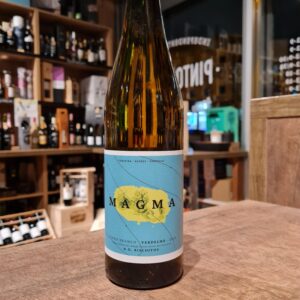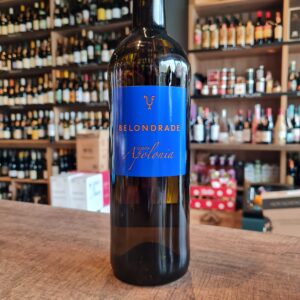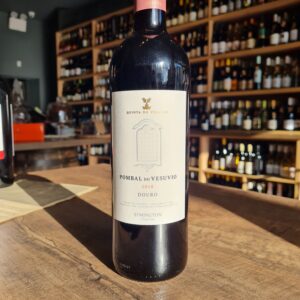-
 Adega Cooperativa dos Biscoitos was founded in 1999, in the Parish of Biscoitos, on the island of Terceira, Azores. In the century In the 16th century, the Biscoitos wine took on a notable importance when supplying the Caravelas on the Indies and Spices route. Among the products supplied to supply the fleets, there was Verdelho wine. This micro-region Biscoitos, is volcanic to the core, made from Verdelho grape variety. The location is part of UNESCO World Heritage. Wine is currently produced here only on a mere 9 hectares. The vineyards are planted in the so-called ‘curraletas’ of Biscoitos, part of the landscape and heritage of the Terceira Island. The vines grow on volcanic soils, surrounded by magma rocks that protect them from the strong winds of the Atlantic, originating a unique and special wine. Stunning wine that is worth every penny.
Adega Cooperativa dos Biscoitos was founded in 1999, in the Parish of Biscoitos, on the island of Terceira, Azores. In the century In the 16th century, the Biscoitos wine took on a notable importance when supplying the Caravelas on the Indies and Spices route. Among the products supplied to supply the fleets, there was Verdelho wine. This micro-region Biscoitos, is volcanic to the core, made from Verdelho grape variety. The location is part of UNESCO World Heritage. Wine is currently produced here only on a mere 9 hectares. The vineyards are planted in the so-called ‘curraletas’ of Biscoitos, part of the landscape and heritage of the Terceira Island. The vines grow on volcanic soils, surrounded by magma rocks that protect them from the strong winds of the Atlantic, originating a unique and special wine. Stunning wine that is worth every penny. -
 The winery was founded by Didier Belondrade who came to Rueda and was inspired to apply Burgundian winemaking techniques to create exceptional white wines from the local Verdejo grape. What began in the mid-1990s as a tiny project using rented vines and a small corner of a friend’s winery quickly blossomed into Belondrade’s own winery on the La Seca plateau some 760 metres above sea level. Here Belondrade has some 30 hectares of vines planted on pebbly soils over a sub-layer of clay and sand. The exact character of the soil varies greatly from plot to plot, allowing Belondrade to select the precise personality of each wine to reflect the vintage and the micro-terroirs of his vineyards. Enjoy it with Aperitif, Cow´s or sheeps cheese, Grilled vegitables, Grilled whitefish, Light hors d´oeuvres, Mushrooms, Pica Pica or local traditional tapas, Poultry, Roasted red meats, Smoked foods.
The winery was founded by Didier Belondrade who came to Rueda and was inspired to apply Burgundian winemaking techniques to create exceptional white wines from the local Verdejo grape. What began in the mid-1990s as a tiny project using rented vines and a small corner of a friend’s winery quickly blossomed into Belondrade’s own winery on the La Seca plateau some 760 metres above sea level. Here Belondrade has some 30 hectares of vines planted on pebbly soils over a sub-layer of clay and sand. The exact character of the soil varies greatly from plot to plot, allowing Belondrade to select the precise personality of each wine to reflect the vintage and the micro-terroirs of his vineyards. Enjoy it with Aperitif, Cow´s or sheeps cheese, Grilled vegitables, Grilled whitefish, Light hors d´oeuvres, Mushrooms, Pica Pica or local traditional tapas, Poultry, Roasted red meats, Smoked foods. -
 The Quinta of Vesúvio has a long and history. António Bernardo Ferreira bought the property in 1823, at that time called Quinta das Figueiras. The property was mostly covered with wild scrub stretching up the mountainside and an abundance of fig trees, which gave it its name. He felt that this property had enormous potential as vineyards. It took his team of five hundred workers thirteen years to carve terraces out of the steep slopes and plant thousands of vines. In 1827, Ferreira built the winery, with its eight granite lagares (large, open vats or troughs), in which wine grapes are crushed by foot to this day, and eight chestnut vats, each capable of holding the equivalent of one lagar of Port. This original winery is where all of Vesúvio’s Port is still made. The Quinta do Vesuvio been in the Symington family since 1989 and it totals about 326 hectares, of which 133 are planted with vines. This is Vesúvio’s second-tier wine and its is named after the estate’s dovecote, a structure intended to house pigeons or doves, or “pombal” in Portuguese, which is surrounded by vineyards. Unlike the first-tier fruit, the grapes are transported to the Quinta do Sol winery for processing and fermentation. The contrast between the property's quotas provides the wines with unparalleled structure, complexity and aging potential, as well as the preservation of traditional wine production methods, which highlight Quinta do Vesuvio as the only one that actively continues to create its wines with this base. A Quinta of enchanting and memorable beauty, worth the visit but with outstanding wines.
The Quinta of Vesúvio has a long and history. António Bernardo Ferreira bought the property in 1823, at that time called Quinta das Figueiras. The property was mostly covered with wild scrub stretching up the mountainside and an abundance of fig trees, which gave it its name. He felt that this property had enormous potential as vineyards. It took his team of five hundred workers thirteen years to carve terraces out of the steep slopes and plant thousands of vines. In 1827, Ferreira built the winery, with its eight granite lagares (large, open vats or troughs), in which wine grapes are crushed by foot to this day, and eight chestnut vats, each capable of holding the equivalent of one lagar of Port. This original winery is where all of Vesúvio’s Port is still made. The Quinta do Vesuvio been in the Symington family since 1989 and it totals about 326 hectares, of which 133 are planted with vines. This is Vesúvio’s second-tier wine and its is named after the estate’s dovecote, a structure intended to house pigeons or doves, or “pombal” in Portuguese, which is surrounded by vineyards. Unlike the first-tier fruit, the grapes are transported to the Quinta do Sol winery for processing and fermentation. The contrast between the property's quotas provides the wines with unparalleled structure, complexity and aging potential, as well as the preservation of traditional wine production methods, which highlight Quinta do Vesuvio as the only one that actively continues to create its wines with this base. A Quinta of enchanting and memorable beauty, worth the visit but with outstanding wines.

